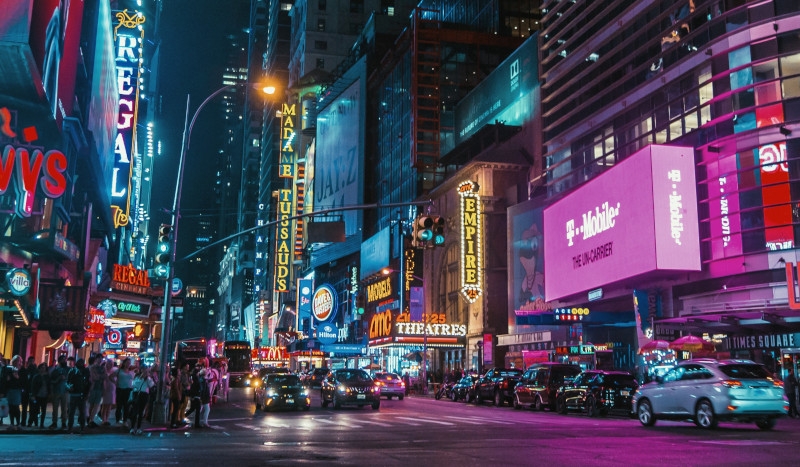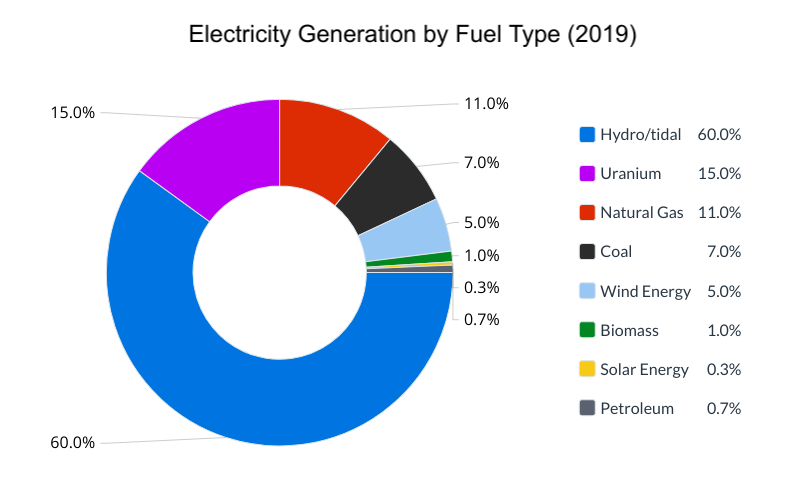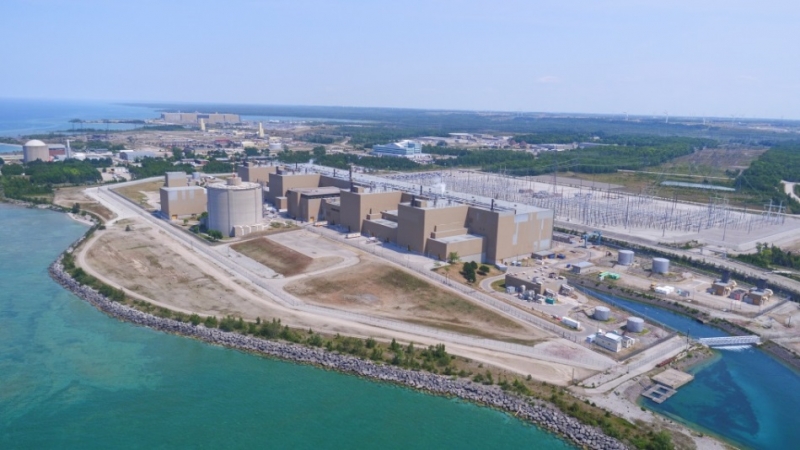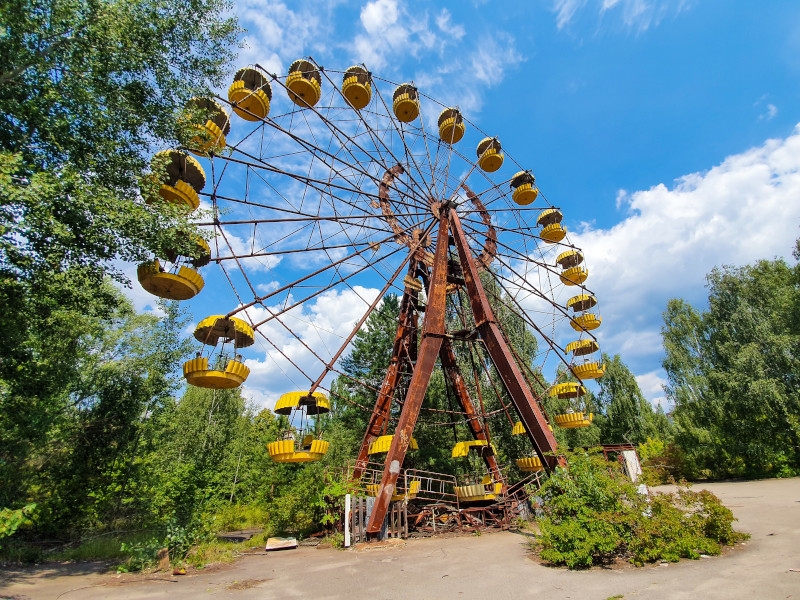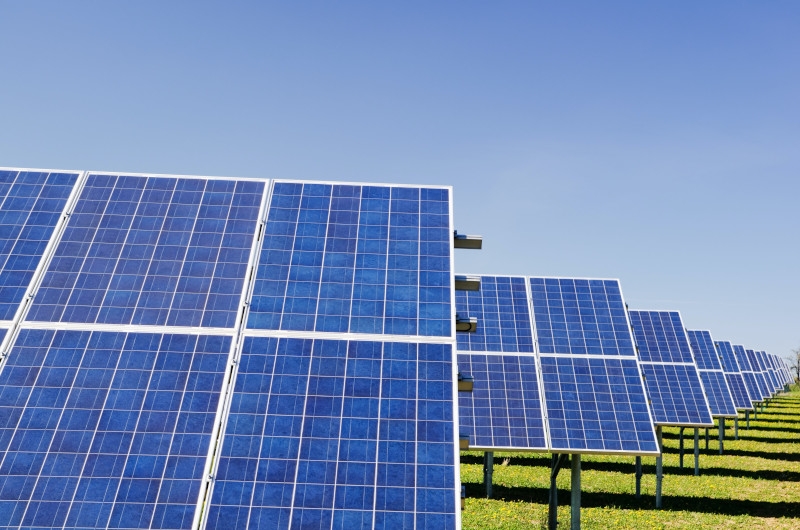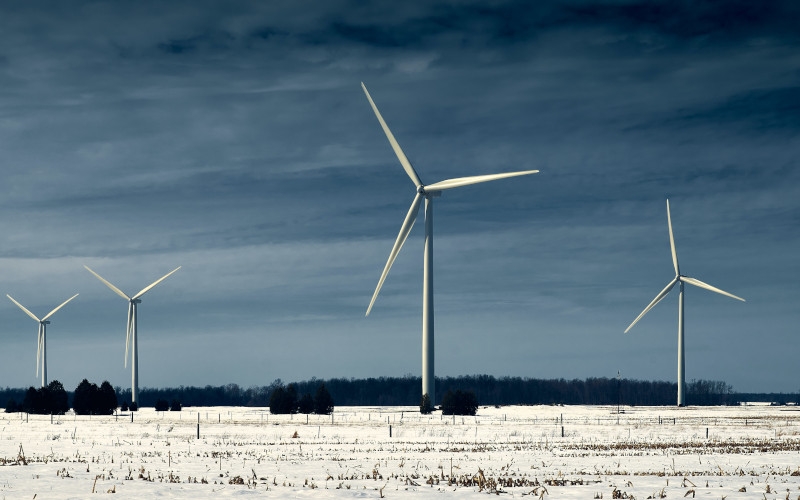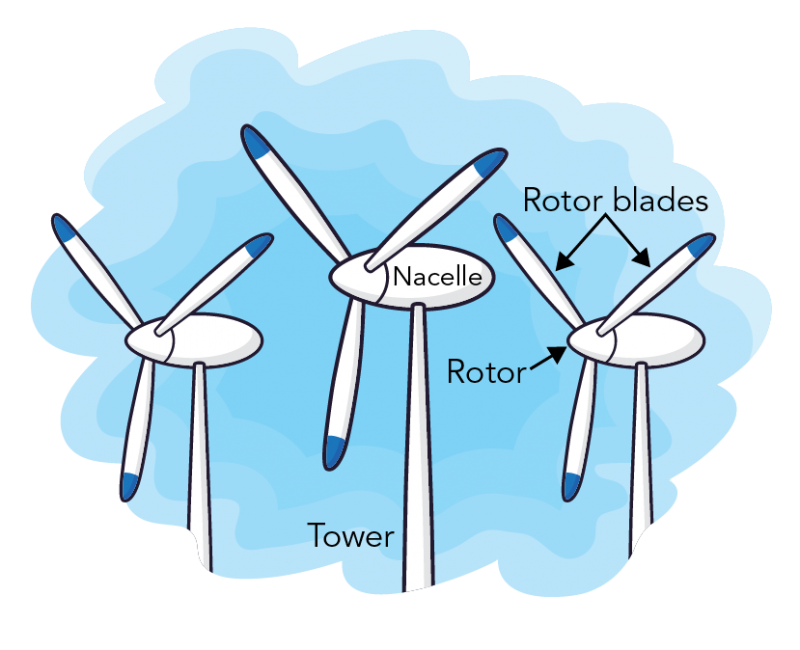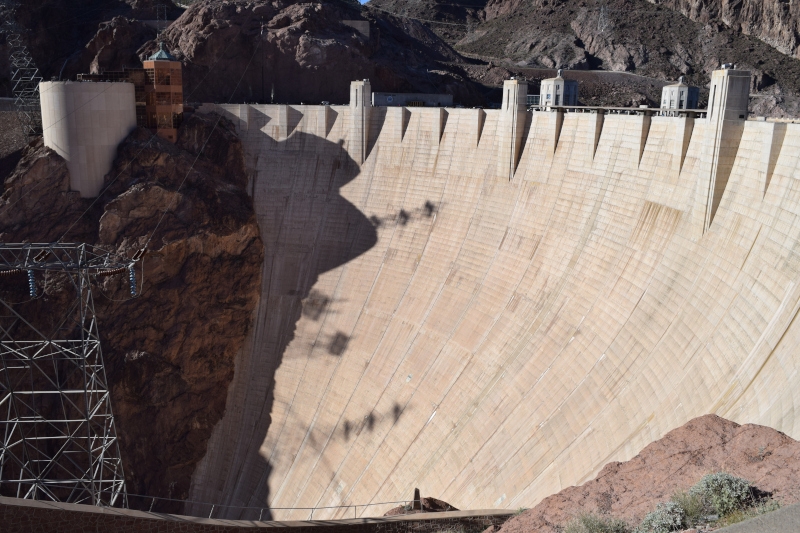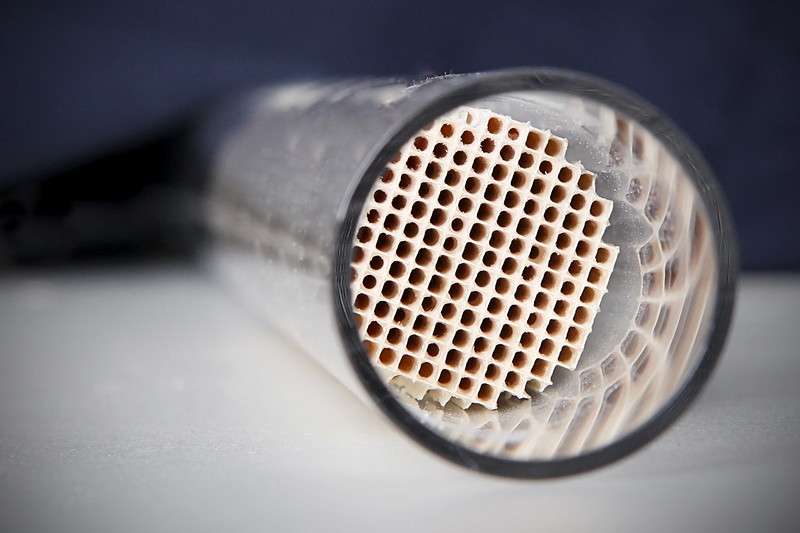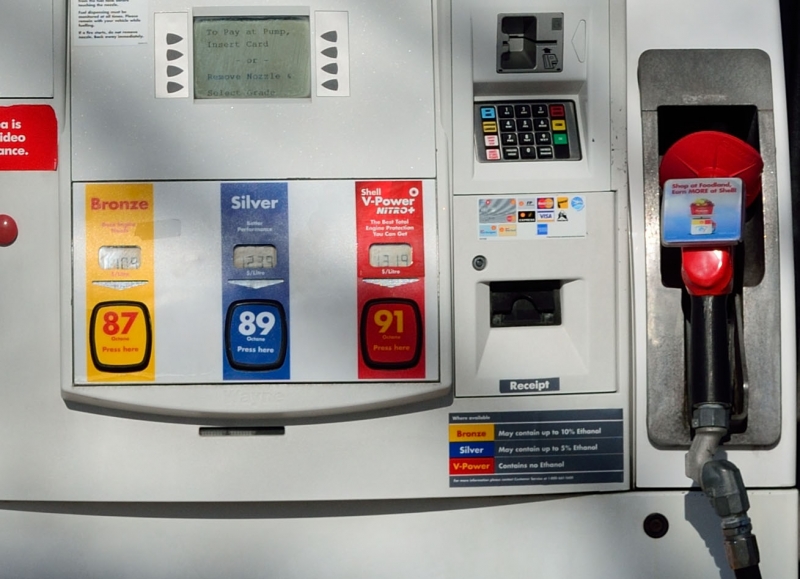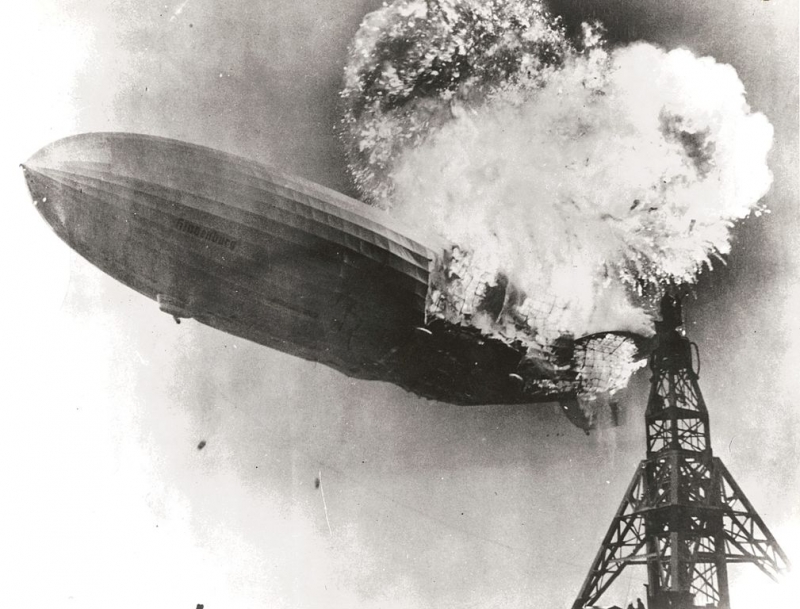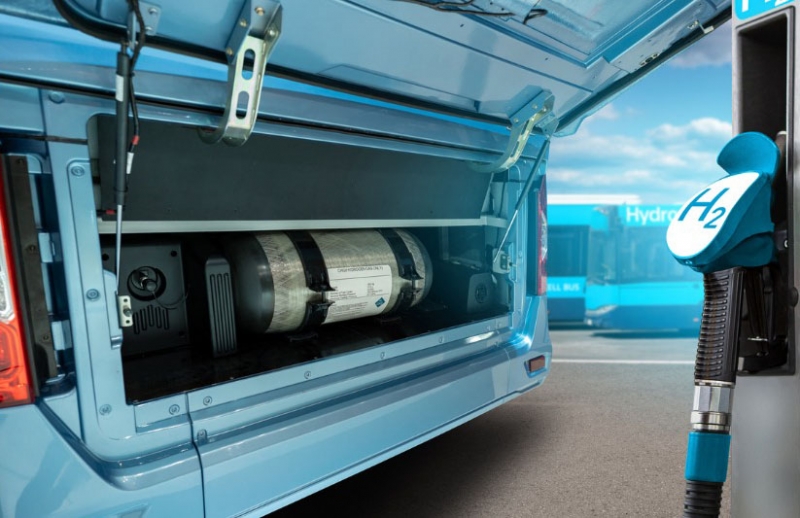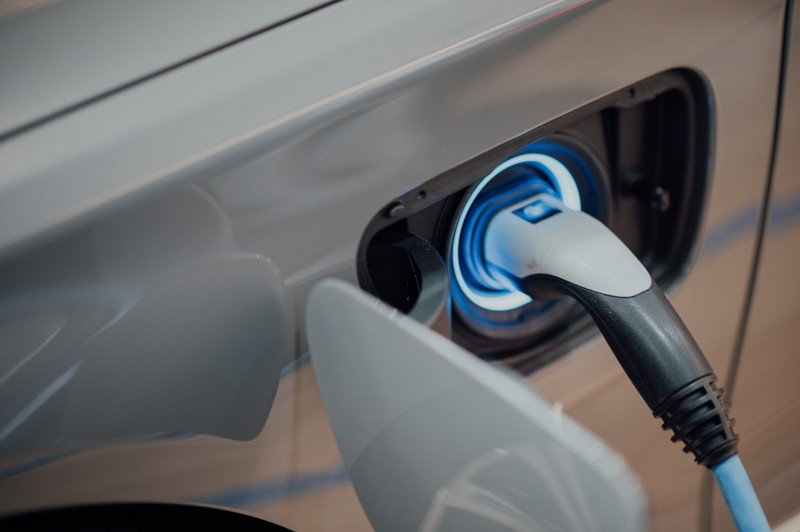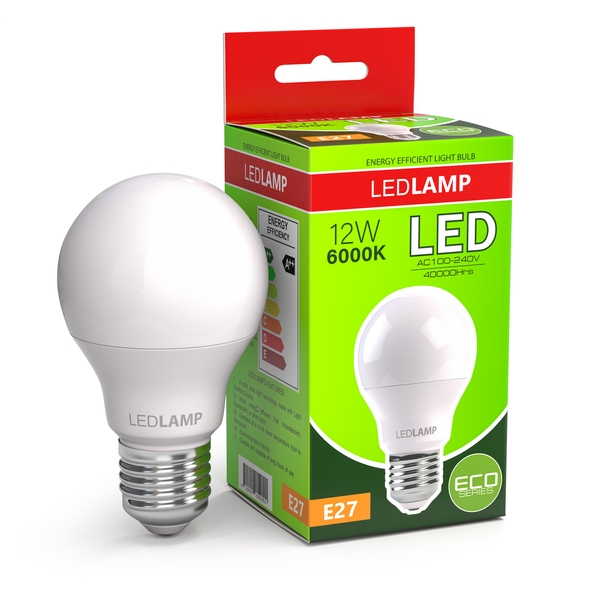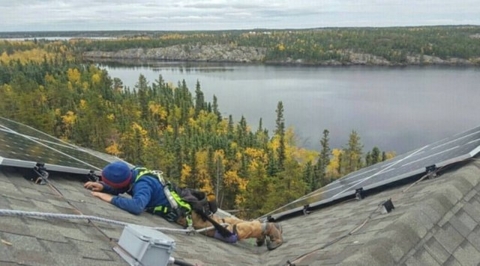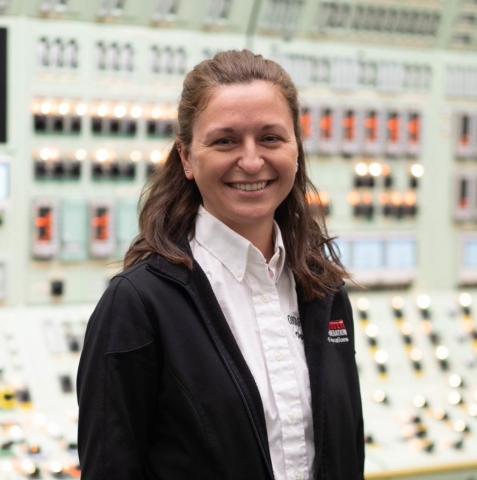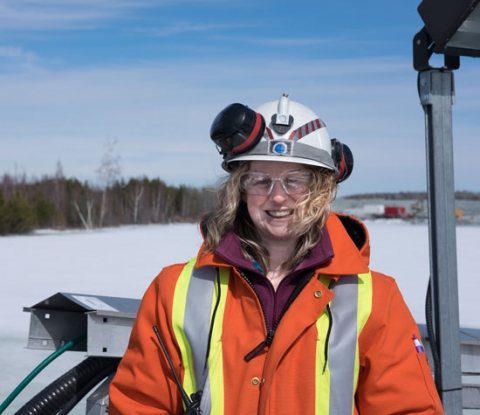
Green Energy
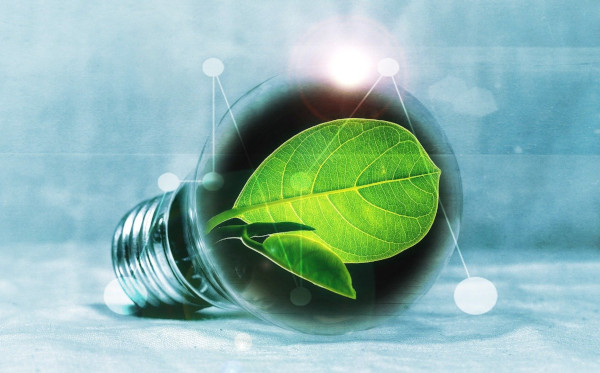
Green leaf inside of a light bulb (PIRO4D, Pixabay)

Green leaf inside of a light bulb (PIRO4D, Pixabay)
How does this align with my curriculum?
An overview of environmentally-friendly ways to generate electricity and power
Energy
Energy can be broadly defined as the ability to do work. It’s what we need to ride bikes, light up our homes, and drive our cars. Energy takes on many forms. These can be grouped into two categories: potential energy and kinetic energy. We use both every day, and often convert one into the other to perform tasks.
When it comes to our modern world, two uses of energy are extremely important. The first is the energy we use to generate electricity. The second is the energy we use to make our vehicles move from one place to another. Both of these activities involve huge amounts of energy.
Electricity Generation
Image - Text Version
Shown is a colour photograph of a street corner lit by dozens of neon signs.
Every building along both sides of the street is covered with neon signs. Some are advertising billboards, some are store names, and many are theatre marquees. There is a street light in the middle ground, and an illuminated office tower in the background. In the foreground, a two lines of cars, with headlights on, wait at the intersection. A crowd of people stand on the sidewalk at the corner.
Image - Text Version
Shown is a colour diagram of a generator, with parts labelled and arrows indicating motion.
The background is yellow. At the top, a large black circle is connected to a smaller black circle with a black loop. Both circles have arrows curving around them, pointing to the left. The larger circle is labelled Connection to Turbine. The smaller circle is labelled Rotor.
From the rotor, a long grey pole leads down through an orange ring at the bottom centre of the diagram. On either side of the pole is an orange line that forms a square. There is a gap at the bottom of the square, where a line from each side is attached to the ring. The square is labelled wire coil, and the ring has a curved arrow around it, pointing to the left.
To the left of the wire coil is a red, rectangular block with a white letter N on the front. On the right side of the block, five blue arrows point right, toward the wire coil. The block is labelled Stator (magnet).
To the left of the wire coil is a blue, rectangular block with a white letter S on the front. On the left side of the block are five arrows pointing right, toward the block. This block is also labelled Stator (magnet).
On either side of the orange ring are square black blocks. A red line extends from the bottom of the diagram, turns right, and reaches the left block. On the other side, a blue line extends horizontally from the right block, then turns down to the bottom of this diagram.
Purple arrows move along the red and blue lines, starting from the bottom left, up and across the orange ring, and down to the bottom right of the diagram. This is labelled Direction of Electric Current.
Image - Text Version
Shown is a colour graph showing the percentage of different types of electricity generated in Canada.
The graph is labelled with the title Electricity Generation by Fuel Type (2018). It is a large circle divided into eight different coloured sections. A legend below indicates which fuel is represented by which colour, and the percentage of each.
The largest section is labelled Hydro/Tidal, with 61% in dark blue. The next largest is labelled Uranium with 15% in yellow. Natural gas is 9% in red. Coal is 8% in black. Wind is 5% in pale blue. Biomass is 1% in green. Solar is less than 1% in yellow. Petroleum is also less than 1% in grey.
Transportation
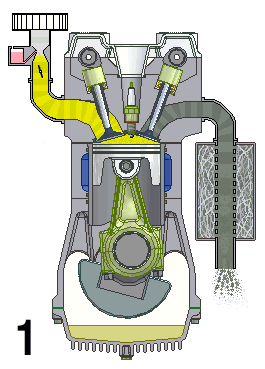
This animation shows the four steps that occur in a combustion engine. The fuel enters at the left and the waste gases exit at the right (Source: UtzOnBike (derivative work) via Wikimedia Commons).
Image - Text Version
Shown is a colour animated GIF that shows what happens inside an internal combustion engine.
In the bottom left corner, black numbers cycle through 1, 2, 3, and 4 on a loop.
On the top left, a yellow substance flows through a pipe. At the bottom of the pipe, a grey stopper on the end of a moving pole, moves up and down, blocking, then allowing the liquid to move into a chamber below.
When the chamber is full of yellow liquid, a white spark from a green plug in the roof of the chamber turns the chamber red. The chamber then quickly turns grey.
When the chamber is grey, a stopper on the top right of the chamber lets the grey substance up through a pipe. The end of this pipe spews grey fumes, like the exhaust pipe of a car.
At the bottom of the chamber, wide grey object moves up and down in a steady rhythm. It moves down when the chamber becomes yellow, then up until the spark, then down when it's grey.
A large, round green object with a pointed triangular top, hangs from a hinge on the bottom side of the wide grey object. A grey half-circle attached to it moves smoothly around an empty chamber.
Electrical generation and transportation are important to everyday life. But they come with costs. Burning fossil fuels to generate electricity or power vehicles releases greenhouse gases (GHGs). These gases collect in the atmosphere. They trap heat from the Sun that would otherwise reflect back out into space. Greenhouse gases are the major contributor to climate change.
Burning fossil fuels produces other pollutants as well. For example, burning coal and oil releases nitrogen oxides and sulphur dioxide gas. These pollutants can lead to acid rain, which harms soils, forests, lakes, and rivers. Burning fossil fuels, particularly coal, also releases particulate matter into the air. Particulate matter can lead to heart attacks, strokes, lung cancer, and other diseases.
Getting fossil fuels out of the ground can also impact the environment. For example, natural gas can be obtained through fracking. This process can lead to contaminated groundwater and drinking water. It can also release methane, which is another greenhouse gas.
Thankfully, we can generate electricity and move our vehicles using sources of energy other than fossil fuels. Let’s look at some of these “green” energy sources.
Green Electricity Generation
Electricity generated using “Green” energy sources does not produce GHGs. This includes energy from sources such as uranium, moving air, moving water and the Sun. Running solar panels or wind turbines does not produce GHGs. But building them does produce small amounts.
Nuclear Energy
Image - Text Version
Shown is a colour, aerial photograph of large grey and beige buildings next to water.
In the centre is a row of four similar, blocky beige buildings. In front of that is another blocky building, and a grey, cylindrical structure, about the same height.
In the foreground is the curving shoreline of a greenish blue body of water. There is also another body of water to the right of the buildings, separated from the larger one by a wall of earth.
The fission process takes place in a specialized chamber called a reactor. Pellets of uranium are lined up in cylinders called fuel rods. The rods are then submerged in water. The water keeps the fuel rod temperature under control. In some reactors, called pressurized water reactors, the heated water is used to heat another pool of water. This second pool creates the steam. In other reactors, called boiling water reactors, the steam is generated from the same pool the fuel rods are submerged in.
The biggest advantage of nuclear power is that it doesn’t emit greenhouse gases. In terms of its contribution to climate change, it is a clean energy.
Image - Text Version
Shown is a colour diagram of the inside of a fuel rod, its assembly, and rods inside a storage cask.
There are three illustrations on an orange background.
In the centre is yellow circle with a long, straight vertical structure made up of light blueish grey rods arranged in a square. It is capped with a square brown top, and appear held together with square brown bands. This is labelled Spent Fuel Assembly, with a black line and dot.
A faint yellow cone extends from one of the rods to a yellow circle on the right. This is a close-up view of one of the rods.
The rod itself is labelled Fuel Rod. The lower part of the rod is cut away to reveal it is filled with a stack of brown cylinders. One of the cylinders is labelled Uranium Fuel Pellet.
On the right is an illustration of a wide brown cylinder, labelled Storage Cask. It is cut away to reveal it's filled with about 24 spect fuel rod assemblies, packed close together.
Image - Text Version
Shown is a colour photograph of a ferris wheel surrounded by overgrown trees.
The spokes and supports of the wheel are dark red and streaked. The round cars are bright yellow with matching canopies. Large bushy green trees grow around the wheel. Some branches reach between the spokes. Some branches grow up from the cement in the foreground. In the background, the sky is bright blue with a few white clouds.
Did you know?
France, Russia, and Japan have processes that recycle nuclear fuel. Rather than dispose of it, these plants refine it so that it can be used in reactors again.
Did you know?
A recent agreement in Canada aims to use SMRs to move provinces like Alberta, Saskatchewan, and New Brunswick away from coal-generated electricity.
Solar Energy
Energy from the Sun can also be used to generate electricity. Unlike fossil fuels or nuclear power, no heat is involved. Like nuclear reactors, generating electricity using solar energy does not produce GHG emissions. Another advantage of solar power is that it is that the Sun is a source of renewable energy since the Sun is unlikely to run out of energy any time soon.
Image - Text Version
Shown is a colour photograph of a long line of solar panels under blue sky.
The camera shows the right end of many rows of panels, tilted up to the sky. The first row is made up of at least six smaller, rectangular sections joined together by silver frames. Each section is dark blue with a grid of silver lines. The ends of many identical rows stretch off into the distance.
Green grass is visible below the panels. The sky above is clear, deep blue.
Currently, solar panels only convert around 20% of the solar energy they capture into electricity. This is not very much. To get more out of solar panels, researchers are experimenting with new types of photovoltaic cells. One group was able to convert up to 47% of solar energy. By making cells more efficient, they would not need to be as large. This could make them more practical to use.
Wind Energy
Image - Text Version
Shown is a colour photograph of four turbines against dark clouds.
A row of tall, thin turbines with three blades, sit along the horizon. They gleam in low sun. The fields in the foreground are covered in snow. There are dark trees on the horizon and the sky is streaked with dark blue and grey clouds.
Image - Text Version
Shown is a colour illustration of three turbines, with their parts labelled.
The long, thin stem supporting the turbine is labelled Tower. At the top, the central, torpedo-shaped hub is labelled Nacelle. The pointed cone at the front of the nacelle is labelled Rotor. The three long, thin, tapered arms that extend out from the rotor are labelled Rotor blades.
The taller the tower, the longer the rotor blades can be. The longer the rotor blades, the more electricity the wind turbine can generate. Large numbers of wind turbines are often grouped together to form wind farms. These wind farms can generate a large amount of electricity.
Did you know?
The largest such farm in Canada is the Lac-Alfred Wind Project in Quebec, which generates 300 megawatts.
Energy from Moving Water
Energy from moving water can also be used to generate electricity. Hydroelectric generating stations work in a similar way to wind turbines except they use moving water instead of moving air to generate electricity. Moving water, like wind and solar energy, is a source of renewable energy. And like wind turbines, hydroelectric stations do not produce GHG emissions.
Did you know?
Nearly 60% of the electricity generated in Canada comes from moving water.
Image - Text Version
Shown is a colour photograph of a massive cement wall surrounded by cliffs.
A tall, smooth, curved, beige structure stretches across a canyon. In the distance, the cement is tightly sealed to a jagged cliff face. It curves all the way around so the top edge is just visible in the bottom left corner, like half a gigantic clay bowl.
There is a beige cylindrical structure nestled in the rocks at the far end of the wall, and part of an electric pylon is visible in the foreground.
Did you know?
Energy from moving water is used to provide nearly all electricity for the provinces of British Columbia, Manitoba, Newfoundland and Labrador, and Quebec, as well as the territory of Yukon.
Did you know?
The world’s largest hydroelectric dam - and the biggest electricity generation station on Earth in terms of output - is the Three Gorges Dam in China.
Green Energy for Vehicles
Much like fossil fuel-based electricity generation, vehicles produce GHGs as a by-product of the combustion reactions that take place in their engines. The combustion of gasoline and diesel fuel is a major contributor to climate change and poor air quality.
Luckily there are some up-and-coming green alternatives to this process.
Image - Text Version
Shown is a colour photograph of a tube with perforated gold coloured material inside.
The camera looks into the end of a shiny metal tube. Partway down, the tube is blocked with a circle of pale gold material. This is perforated with tiny holes, forming a fine grid.
Did you know?
The demand for these metals and their cost is now so high that thieves are stealing catalytic converters from cars!
Biofuels
Image - Text Version
Shown is a colour photograph of a field of tall green plants under blue sky.
The bottom two thirds of the photograph is filled with densely packed plants. They are tall and green with long pointed leaves that reach up into the sky. Above, the sky is bright blue, streaked with white.
Image - Text Version
Shown is a colour photograph of the front of a fuel pump.
The front wall of the pump is pale grey. There is a yellow button, a blue button, and a red button indicating different types of gasoline. Low on the right is a small, dark grey sticker with matching yellow, blue, and red rectangles. Each one has small white printing next to it.
There is an LCD screen at the top, a keypad to the top right, and the handle of the pump on the far right.
The main advantage of biofuels is that they are a renewable resource. This is because they are made from crops that can be grown continuously. One of the drawback of biofuels is that they still emit GHGs when they are burned. So why do people consider this a “green fuel”? Biofuels are considered to be green because they are carbon neutral. The plants grown for biofuels take in the same amount of CO2 as they grow as they produce when they are burned. There is some debate as to how truly neutral they are because it often takes fossil fuels to grow the plants and manufacture the fuels.
Another drawback is that biofuels use agricultural land. This land could otherwise be used for growing food. By diverting corn harvests from food to fuel, it reduces the supply of corn for people. This can cause food prices to rise, and with it food insecurity. As a result of the “food versus fuel” debate, scientists are looking for ways to use waste plant materials rather than edible plant products for making biofuels.
Hydrogen Energy
Human beings have been trying to harness the potential of hydrogen since it was first identified in 1671. It is the simplest , and the most abundant element in the universe.
Image - Text Version
Shown is a black and white photograph of an airship exploding as it hits a tower.
The ship is dark grey, ribbed, and shaped like a torpedo. The back half is consumed by a huge, bright, ball of fire. In the bottom right corner, the black metal struts of a tower can be seen.
The explosive potential of hydrogen made it unsuitable as a lifting gas. However, that explosiveness makes it useful to replace fossil fuels in vehicles.
Image - Text Version
Shown is a colour photograph of a pale grey cylinder strapped in a large compartment with a blue metal door.
The pale blue door is pulled open to the top of the photograph, revealing a compartment that takes up all the space between two tail lights of a vehicle. Inside is a pale grey cylinder about half the size of the compartment. It is held in place by two black bands fastened around it.
In the foreground, on the right, is a hose with a handle, attached to a silver rectangular object. This looks very similar to a gas pump. The handle is bright blue with a white panel labelled H2 (2 in subscript)
Electric Vehicles
The increased focus on climate change has caused a rise in interest in electric vehicles. These are vehicles that are either completely or partially powered by a battery.
Image - Text Version
Shown is a colour photograph of an electric cord plugged into a blue socket behind a small silver door.
The small door in a smooth silver panel looks very similar the cap of a car's fuel tank. Inside is a black compartment with a glowing blue circle, where a blue cord is plugged in.
In addition to using batteries, these vehicles often have other emission-reducing features.
This can include using the brakes to convert the vehicle’s into . This energy is then stored in the battery.
Some vehicles will use a start-stop system, which shuts the engine down when idling. This can cut down the amount of GHG emissions that HEVs produce.
Electric vehicles are becoming more common on the road. They are an important part of reducing our overall GHG emissions. Like anything, though, they come with some drawbacks.
One downside to electric vehicles is that the electricity that they use to charge the battery may be generated using fossil fuels. In this case, the vehicle still contributes to the overall emissions of GHGs into the atmosphere.
Electric vehicles will continue to be important in reducing overall GHGs. More work must be done to ensure that they are truly a green alternative.
What You Can Do
Energy sources are a major contributor to climate change, so we should do everything we can to help find a solution.
Image - Text Version
Shown is a colour photograph of an opaque white lightbulb next to a box labelled LED.
On the right, a lightbulb sits straight up on its base. The top is round and white, There is a pale grey section below, printed with the words LEDLAMP in grey. The base is silver metal with threads.
The box is bright green with a picture of the same lightbulb on the front. It is labelled LEDLAMP at the top. LED, 12W, 6000K, Eco and E27 are also printed on the box.
Image - Text Version
Shown is a colour photograph of a laptop with the screen divided into 25 sections, each showing a different face.
The pale grey laptop sits on a brown wooden table, with a green mug placed on the left. The background appears to be a home, not an office. The image on the screen shows about 25 people from the shoulders up. Each person is in a separate rectangle, with different text in the bottom left corner. This is too small to read.
One of the best contributions you can make is to get involved with a STEM-focused career. Many careers let you work to provide solutions to the problems of fossil fuels and green energy. Below are some examples of people who have worked to have just such a career.
Learn More
Nuclear Reactor Simulator
This interactive website provides a 3D examination of all of the major parts of a working pressurized water reactor.
Nuclear Energy Interactive Guide
This interactive map from The Economist shows the global distribution of nuclear reactors, as well as the uranium requirements for each country.
Solar Power
This video (3:00), from NOVA Labs and PBS Learning Media, provides an overview of solar power and some pros and cons with its use.
Wind Energy Interactive
This ‘virtual wind energy lab’ from 3M lets you design your own wind turbine and test it to see if it can meet the goal of powering at least 400 homes.
Canadian Hydropower Interactive Map
This interactive map from Canadian Geographic shows the location, type, and power generation capacity of every hydroelectric dam in Canada.
Gridwatch
This dashboard shows the current electricity demand and generation for the Province of Ontario. Power generation is broken down by type and by generation station. The dashboard also includes the amount of emissions and the intensity, measured in CO2-equivalent units.
How Do Electric Vehicles Work?
This video (5:06) from Tech Vision explains how electric cars function as well as the difference between the electric engine and the internal combustion engine.
References
Bueckert, K. (Mar 1, 2021). Catalytic converter thefts rise as metal inside 'more valuable than gold.' CBC News.
Canada Energy Regulator (2022). Canada's Energy Future.
CBC News (Mar 28, 2022). 4 provinces push ahead with plan to build small nuclear reactors to supply power.
Chrichton, F., S. Chapman, T. Cundy and K. J. Petrie (2014). The Link between Health Complaints and Wind Turbines: Support for the Nocebo Expectations Hypothesis. Frontiers in Public Health 2: 220.
Frankel, T. C. (Sept 30, 2016). The Cobalt Pipeline. The Washington Post.
International Atomic Energy Agency (n.d.). Fukushima Daiichi Nuclear Accident.
Jaekl, P. (Jun 19, 2017). Why People Believe Low-Frequency Sound Is Dangerous. The Atlantic.
Kharecha, P. and J. Hansen (2013). Coal and Gas are Far More Harmful than Nuclear Power. NASA Goddard Space Flight Center.
Niagara Falls Info (n.d.). Niagara Power Generating Quick Facts.
Nuclear Waste Management Organization (n.d.). How Is It Stored Today?
Science Daily (Jan 14, 2020). How to make it easier to turn plant waste into biofuels.
Science Daily (Apr 14, 2020). Six-junction solar cell sets two world records for efficiency.
U.S. Energy Information Administration (2021). Biofuels Explained: Ethanol and the Environment.
U.S. Nuclear Regulatory Commission (Mar 2022). Backgrounder on Chernobyl Nuclear Power Plant Accident.
U.S. Office of Energy Efficiency and Renewable Energy (n.d.) Biofuel Basics.
U.S. Office of Nuclear Energy (Mar 29, 2021). Nuclear 101: How Does a Nuclear Reactor Work?
